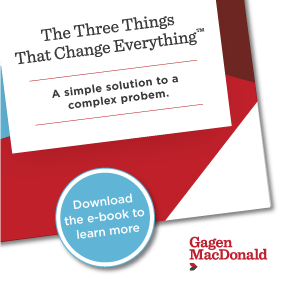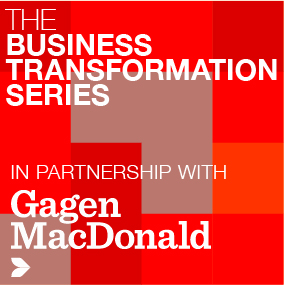Gagen MacDonald 20 Jun 2019 // 9:38PM GMT
By Maril MacDonald
Large companies today are contending with an astonishing array of challenges. They must simultaneously continually reinvent themselves to fend off disruption, deliver quarterly results to satisfy shareholders, compete for top talent in a brutal battlefield, confront political instability and uncertainty, protect their brand and reputation, and nurture their organizational culture. In short, they’re driving constant transformation.
When things feel unruly or overwhelming, our impulse is to try to organize them in a way that makes them seem manageable. We create projects.
But you can’t achieve a business transformation with a project management mindset. Rather, for companies to continually reinvent themselves in the way the modern economy requires, business transformations need to look less like mega-projects and more like social movements.
Whether it’s the Arab Spring, Black Lives Matter, the yellow vest movement, or #MeToo, in today’s hyper-connected world, we’re constantly reminded of social movements’ ability to quickly catch fire and turn whole parts of society on their head. Thought leaders such as Greg Satell, who has published several articles on this topic for Harvard Business Review, have uncovered a cluster of traits that are common to successful social movements. There are several insights from that research that I believe are relevant to our companies’ leadership and communication philosophies today. I want to highlight a few of those insights here.
First, social movements occur when an ideologically diverse coalition of people with varied interests unite around a common objective. We see this all the time. The #MeToo movement, for instance, has drawn everything from young, left-wing political activists to former Fox News hosts Megyn Kelly and Gretchen Carlson. While these women may not agree on everything, they share a common goal with the movement.
Not only do successful social movements draw from many walks of life, they also tolerate—and even promote—many agendas. In the case of #MeToo, some movement members have focused on empowering victims of sexual harassment and promoting community healing. Others have a strong legislative and political bent and view #MeToo as an opportunity to address structural gender inequality in many forms. The movement has been made stronger by the fact that these agendas co-exist.
In my experience, business transformations frequently fail to take off because they are seen as the property of a narrow band of people, and because employees are asked to deliver the transformation, not create it. As an example, many companies today are pursuing various types of digital transformation. However, while these undertakings are crucial to the long-term success of the whole enterprise, in the eyes of employees, they are often reduced to being an “IT thing”. In this type of environment, employees may comply with required training but they won’t creatively contribute to truly maximizing the company’s digital potential.
Rather than rolling things out, we need to roll people in. Instead of showing employees roadmaps and dictating their role, we need to spark their passion and invite their help. Then, let them connect, create, and deliver their many agendas. Transformation is a beautiful mess!
Second, social movement members are highly unified around a common understanding of today’s reality. In Greg Satell’s studies, he found that one of the ways that social movements are able to withstand the presence of multiple agendas and competing ideas regarding the path forward is that while there may be disagreement on the solution, there is unity regarding the problem.
This is an area where I see many companies struggle.
Whether it’s financial pressure, shifting consumer behavior, operational inefficiency, or the introduction of new technology, business transformations are all responses to some impetus or issue. In many cases, there’s not misalignment on the path forward—rather, there’s misalignment on the need for transformation in the first place. This is due to a deeply held fear that discussing challenges openly, frankly and transparently will cause morale to suffer, engagement to diminish, and turnover to spike. In reality, if you’re afraid that discussing the challenges you face will cause you to lose your employees, your employees are already lost.
Companies that transform over and over again understand that the benefits of having a team highly aligned around a common challenge vastly outweighs the risk of demoralization. Organizations that can simultaneously communicate both a compelling vision for the future and a clear-eyed view of today’s obstacles—what MIT professor Peter Senge has long called “creative tension”—are able to create the space necessary for a transformational movement to exist.
Finally, social movements gain momentum via face-to-face engagements, not just messaging or mass communication.
While we tend to think of social movements on their grandest scales, at their core, they’re hyperlocal. As the writer Charles Duhigg explores in great detail in his book, The Power of Habit, while we primarily associate the Civil Rights Movement of the 1950s and 1960s with events like the March on Washington, its roots were in the small social networks of southern black communities. In those churches and living rooms, dialogue between family and friends and pastors and parishioners came together and catalyzed change.
When driving business transformation, it’s easy to become myopically focused on how and what CEOs and other C-suite leaders say and do. While of course this is important, executives cannot deliver change by themselves. Change will come when small groups of people inspire each other to join something new. We need to enable this change by being attuned to how influence operates within our companies—knowing, to a person, which individuals have the ability to move the needle, and equipping and enabling them to be agents of transformation.
Ultimately, the key that underlies all common characteristics of creating a successful social movement is a willingness to let go. When things are clutched closely and managed like a project, they can only be as big as what fits on a spreadsheet. However, when you have the courage and patience to light a spark and let it take hold, your potential becomes limitless.
Learn more about how you can help drive your company’s business transformation in Gagen MacDonald’s The Three Things that Change Everything™ e-book.
Maril MacDonald is the CEO and founder of Gagen MacDonald, a leading strategy execution firm. She is a nationally recognized leader in communication, strategy execution and business transformation. Maril has pioneered a discipline that collaborates with corporate leaders to energize and mobilize their workforce behind a company’s strategic goals, culture and brand to optimize business performance.


































.jpg)














